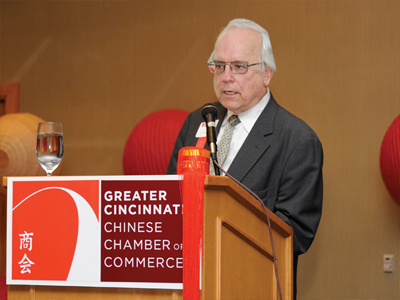|
|
|
|
|
|
| |
中國是美國生活的一部分
|
|
 |
|
俄州大敎授,全美東亞語文資源中心主任 吳偉克 |
|
大辛辛那提中國商會新年聚會上的嘉賓演講詞 (2011年元月28日) |
|
| |
|
| |
首先祝大家兔年快樂。萬事如意!
我要感謝大辛辛那提中國商會邀請我參加這個盛會。
最近我擔任了美中西部美中協會會長,正在考察美國社區爲了吸引中國商資主要做了什么。毫無疑問,辛辛那提在這方面走在前面。我渴望更多地瞭解各位和你們的組織。
我今晩的任務是應邀做演講。美國和中國都有類似的説法:“魚放三天臭,客住三天嫌”,嘉賓們忍耐度有限,特別不能容忍客座演講者冗長的講話。所以,作爲一個敎授,儘管天性愛説話,儘管我對這個話題特別熱忱,但我會儘量講得簡短扼要。
我只想談一點:從現在起,中國正在成爲美國生活的一部分。誰認識到了這一點,並且制定了理性的政策,發展了相應的關係,採取了深思熟慮的行動,誰就具有重大的優勢。這點對地區,機構和個人都適用。
我的工作使我每年大約有十分之一的時間待在中國。最近的一次旅行中,我在那里待了一個月,直到選舉前夕才回美國。儘管在工作中我遇到的美國人對中國持有各種各樣的態度,當我回國後看到電視廣吿上把中國當作負面角色,我還是深感驚訝。
在這些廣吿里,中國成了美國人失業及美國威望或失的原因。任何想尋求公職的人,如果從事美中貿易,或鼓勵、促進雙方關係與交流,那么他(她)對國家的忠誠及對美國大衆利益的關心就會受到質疑。
對於那些不想探索經濟衰退,金融危機,全球化後果等麻煩而複雜的問題的人而言,中國是一個迴避現實的方便藉口,用來掩蓋一些美國根本上的不穩定因素。對於那些懷念敵我分明的冷戰時期的人,中國爲美國自身的問題充當了現成的替罪羊,爲那些人提供了哀嘆他國經濟成功的機會。
哀嘆中國的成功有什么長效的好處很値得懷疑。中國正在崛起成爲世界強國,對美國生活的影響正日益增強,我們對此一點都不感到驚訝,在美中兩國之間發展友好交往的好處是顯而易見的。我們承認兩國之間存在着競爭性的挑戰,但同時能看到,威脅遠遠低於機遇與成長。
要把握這些優勢,我們要提醒美國公衆輿論的代言人重視與中國發展雙贏的關係:
把一方的成功看作另一方的勝利。中國和美國都對發展機遇與促進發展感興趣。
所以,我們必須找到一個方法從“哀嘆”走到“雙贏”。也就是説,去掉一個“h” (whining) 加上一個 “n”(winning).
讓我再花幾分鐘談談我們爲此目的正在做什么和我們以後能做什么。
中國是俄亥俄州以及美國中西部絶大多數州中成長最快的出口市場。這個趨勢似乎會延續下去。如果我們齊心協力與中國建立更加廣泛的聯係,我們能夠以更快的速度去發展這個市場。
如果我們能發展一種策略,吸引更廣泛的中國聽衆,那么正在蓬勃興起的中國商業和中國的中産階層就會帶來源源不斷的遊客和潜在的投資者訪問我們這些州。當他們更多地瞭解美國中西部生活的吸引人之處,我們就能説服他們更多地參與其中。
敎育美國人瞭解中國是個很好的開始。中國悠久的歷史在人類史上佔有重要的地位,其人口現佔全球人口的五分之一,但中國從來不是,現在也不是美國敎育中重要的一部分。要在美國人與中國間建立一種理性的關係,我們必須在我們的敎育中大力加強中國語言與文化的分量。
在俄亥俄,我們正在朝着這個方向大踏步前進。俄亥俄州立大學中文旗艦工程正在正規培養受過中國語言和文化高級訓練的美國年輕人。我們的目的是要訓練他們獲得在中國各領域中使用中文工作的能力,如農業,營銷,生物化學等領域。在他們精通語言和文化之後,他們會去中國各地的組織機構實習,學習中國機構是怎樣運作的。
美國人要瞭解中國人,就必須瞭解在組織和機構里的中國人。
最終結果就是把年輕的美國人放到美國和中國與中國有關的工作崗位上。如果想在爲經濟增長服務的各個領域擴展我們的交往,我們就必須大力增加這批人的數量。他們對在中國和美國經營業務已做好了準備,擅于與中美兩方的人打交道,從事各種各樣的活動。
在把中文敎育引入俄州學校方面,我們也取得了某些進展。2005-06學年間,我們州只有8所學校開設了中文課。2010-11學年間,有117所公立學校或地區開了中文課,學生人數從三百增加到一萬五千,增長了五十倍。在二十一世紀,中文和中國硏究將成爲美國敎育中的主流成分。在這方面起步快的地區將會獲得先機。
俄亥俄州與華人世界,這世界上經濟發展最快的地區,有迅速發展特別關係的可能性。但是,要做到這點,我們必須目的明確,堅持不懈。
芝加哥爲我們樹立了怎么做的最佳榜樣。幾十年來,芝加哥的政治領導人都訪問過中國,也接待過許多中國的來訪者。有一萬二千多公立學校學生學習中文。本月(2011年一月),中國主席選擇芝加哥作爲華盛頓特區外訪問的唯一城市,並高調參加了大型的中美企業家與政府領導人的聚會。這肯定是長期友好合作關係的成果。
在座各位都瞭解美中西部各州,包括俄亥俄州,都面臨赤字預算,但並沒有像芝加哥那樣全力尋求和中國合作的機會。
然而,作爲一個地區去發展和中國的投資與貿易關係是値得我們去努力的。比如説,中西部美中協會是在美中西部十二州州長協會基礎上成立的。現在,這十二個州對華出口的總數還少于西部一個州,如加利福尼亞州與華盛頓州。很清楚,儘管對華出口在急速增長,但還有大幅增進的空間。
就整個地區而言,這十二個州在敎育、商業、技術及文化上面有大量的投入。如果我們遵循這個理念:爲全地區造福,就是爲更多的人與機搆造福,從而找到共同合作途徑的話,那么,我們缺乏的並不是資源,而是缺乏最好的方法來利用我們的資源。
正如在座各位能夠證實的那樣,美中西部有許多特色對中國社會商界正在發達起來的、數目日益增多的一群人很有吸引力。
美中西部和中國享有許多共同的價値。美國高等敎育與硏究的核心都在這一地區;在整個中西部及中國特大城市外的地區同樣都有持續發展經濟的根本需要。
就整個地區而言,我們能開發資源,來有效地適合中國的利益,也能從中國獲得我們的利益。這種地區合作能證明比現在十二州單個處理來臨的機會將更經濟,更有效率。
戰略上來説,如果做好適當的準備,有知識的指導,對中國人和美國人在一起工作進行培訓,然後把中國團體吸引到美國,把美國團體送到中國,這樣我們就能建立基礎廣泛的關係,具有足夠的技能在商務,文化與敎育等關鍵領域共同合作。
例如,我們能在俄州大旗艦工程成功的實習項目的基礎上來培訓具有這種才能的管理與硏究人員。
注重發展互利的項目,即那些適應雙方需要的項目,我們就能着手學習怎樣滿足中西部及中國的需要,將美中關係發展成美中西部文化的另一個方面。
最後,我們要努力讓美中西部的華人社區在中美關係中發揮更重要的作用。華人社區能夠在主要美中西部大城市中扮演擴展的角色,學習怎樣在中國、中國人和其他社區之間建立橋樑。
我已注意到華人社區越來越多地參與當地的敎育與政治,但我建議這個速度還應該更快一些。在自己的社區里保留中國語言和文化,學習怎樣在城市與地區中發展關係,美籍華人正在給美國提供一種極有價値的資源。我們越深入邁進二十一世紀,這種資源就會越有價値。
(李敏儒譯、賈君卿校) |
|
| |
|
|
| |
|
China as Part of
the American Experience
Galal Walker, OSU Professor, Director of National East Asian
Languages Resource Center
(Guest speech at the Chinese New Year Gala organized by the Greater
Cincinnati Chinese Chamber of Commerce on January 28, 2011)
I want to thank the Greater Cincinnati Chinese
Chamber of Commerce for including me in this tremendous event.
I have recently assumed the role of president of the Midwest
US-China Association and have been reviewing the major community
efforts to attract Chinese interest and business across the
throughout the United States. Cincinnati is surely ahead of the game
and I am eager to learn more about you and your organization.
My task tonight is to be a guest speaker. According to sentiments
shared by both Americans (Guests, like Fish begin to smell after
three days) and Chinese (鱼放三天臭,客住三天嫌), there is a limited tolerance
for guests. But the tolerance is radically more limited for guest
speakers. So, I shall keep this brief, despite my every instinct as
a professor and my enthusiasm for the topic.
I simply want to make one point: China is going to be part of
American life from now on and whoever realizes this with rational
policy, reasonable relationships, and calculated actions will have a
significant advantage. This applies to regions, institutions, and
individuals.
My job takes me to China for about 10% of my year. On my last trip I
spent a month there and returned right before the elections.
Although I have encountered a wide range of American attitudes
toward China in my work, I was surprised by the negative role
assigned to China in the television advertisements I encountered on
my return.
In these ads, China is assumed to be the reason jobs are lost and
America’s prestige is at risk. If anyone seeking public office works
for US-China trade or encourages improved relations or exchanges,
his or her loyalty and concern for our well-being is impugned.
For anyone wanting to avoid the troublesome complications of the
recession, the debacle of our financial establishment, and the
consequences of globalization, China is a convenient detour around
reality and a cover for some basic American insecurities. For those
who miss the clear divisions of the Cold War, China offers a ready
scapegoat for our own problems and a chance to bemoan someone else’s
emergence as an economic success.
The whining about China’s successes has dubious long-term benefits.
For those of us who are not surprised that China is emerging as a
great power that is having a growing impact on American lives, the
advantages of a developing accommodation between our two nations are
obvious. While acknowledging that there is a competitive challenge,
we can see that the threat is far less significant?than the chances
of opportunities and growth.
To get to those advantages, we need to nudge the tenor of the
American public discourse on China toward a win-win relationship
where the successes of one side can be seen to be a win for the
other. China and the US are both interested in developing
opportunities and promoting growth.
So, we have to find a way to go from “whining” to “winning”—aside,
that is, from dropping an “h” and adding an “n”.
Let me take a few minutes to talk about what we are doing to this
end and what we could do going forward.
China is the fastest growing export market for Ohio and most of the
rest of the American Midwest. And that seems likely to continue. But
with concerted effort to establish extensive relations in China, we
should be able to grow this market far beyond the present rate of
growth.
If we develop a strategy of appealing to a broader Chinese audience,
the emerging Chinese business and middle-class of China can provide
a steady traffic of visitors and potential investors to our state(s).
When they see the advantages of knowing more about Midwestern life,
we will be able to convince them to become more a part of it.
The education of Americans about China is a good start. While it has
a long history as a significant part of human experience and now
constitutes about 1/5 of the human presence on the planet, China has
not been and is not now a significant part of American education.
For Americans to have a rational relationship with China, we have to
create a significant presence for Chinese language and culture in
our education.
We are making some significant strides in this direction in Ohio.
The Chinese Flagship program at Ohio State is routinely conducting
high-level training of young Americans in Chinese language and
culture with the goal of achieving the ability to work in a variety
of fields in China and in Chinese—in agriculture, in marketing, in
biochemistry. After they have gained the language and culture
expertise, internships in Chinese organizations across the country
have given them the opportunity to learn how Chinese organizations
actually get work done.
To know Chinese people, Americans have to know Chinese people in
their organizations.
The result is the placement of young Americans in China-related jobs
in both the US and China. If we want to expand our contacts in the
different fields that serve economic growth, we will need to
dramatically grow the pool of people who can readily do business in
China and the US—people from both the US in China who can easily
work together in a wide range of undertaking.
We are making some progress in getting Chinese language instruction
into Ohio schools.? In the 2005-2006 school year, there were 8
schools or districts offering Chinese instruction in our state. In
2010-2011 we have 117 public schools or districts regularly offering
Chinese instruction—that is going from about 300 students to over
15,000 in five years. That’s an increase of 50 times. In the 21st
Century, Chinese and China studies will become a mainstream element
in American education. An advantage will go to the regions that make
the first moves in that direction.
Ohio has the potential to quickly develop a special relationship
with the Chinese-speaking world—the fastest growing economic area on
earth. But, we must be purposeful if we are to do this.
Chicago gives us the best example of how this is to be done. Chicago
political leaders have been visitors to China and have been
receiving visitors from China for decades. Over 12,000 public school
students are in Chinese language classes. This month, the president
of China chose to visit Chicago as the only city outside Washington
and headlined a large gathering of Chinese and American business and
government leaders. This certainly has to be seen as the consequence
of a long-term relationship.
It will not surprise anyone here to mention that Midwestern states,
including Ohio, are facing negative budgets and are not now looking
for opportunities to invest in approaches to China similar to those
of Chicago.
It is however a worth our efforts to raise the possibility of a
regional approach to developing an appeal to China for investment
and trade. For example, the Midwest US-China Association is formed
based on the twelve states of the Midwest Governors’ Association.
Currently, the amount of exports to China from these 12 Midwestern
states is less than each of the West Coast states of California and
Washington. Although China-bound exports are increasing at a
significant rate, it is clear that there is plenty of room for
improvement.
Taken as a region, these twelve states have huge assets in
education, business, technology, and culture. If we can find ways to
work together, guided by the idea that we can benefit the more
people and institutions by benefiting the entire region, our problem
will not be the lack of resources but rather the best way to utilize
our resources.
As many people in this room can verify, the Midwest has many
features that can appeal to the increasingly prosperous and
increasingly numerous Chinese in the commercial sectors of China’s
society.
Midwesterners and Chinese share many values. The core of American
higher education and research can be found here, and the fundamental
need for sustained economic development is found both throughout the
Midwest and in China outside the mega-cities.
Collectively as a region we can develop the resources to efficiently
accommodate interest from China and to direct interest from our
states toward China. This regional approach could prove to be both
less expensive and more effective than the current situation where
twelve different states each deal with the opportunities that come
their way.
By strategically bringing Chinese groups here and sending American
groups there with proper preparation and knowledgeable guides and by
training Chinese and Americans to work with each other, we can build
the broad-based relationships and skills to do business together in
critical areas of commerce, culture, and education.
For example, we can build on the successful internship programs like
the one at OSU and build cadres of managers and researchers who can
give us the capacity.
By paying attention to developing reciprocal programs—programs that
meet the needs of both sides, we can set about learning to meet the
needs of the both the Midwest and China and make US-China relations
another facet of Midwestern culture.
Finally, we need to work to bring Chinese-American communities
throughout the Midwest into a prominent role in the relationship.
Chinese-American communities can play an expanded role in the life
of major Midwestern metropolitan areas, learning how to form a
bridge between China and Chinese and the rest of our communities.
I have noticed their increased involvement in local education and
politics and I suggest that be speeded up. By preserving Chinese
language and culture within their own communities and by learning
how to extend relationships into our cities and regions,
Chinese-Americans are providing the United States with a valuable
resource that will only become more valuable as we go farther into
the 21st Century. |
|
 |
| 吳偉克 敎授 |
|
康乃爾大學東亞文學博士,現任俄亥俄州立大學東亞語言文學系正敎授,美國敎育部直屬的全美東亞語文資源中心主任,俄州大中文旗艦工程主任,美國中西部美中協會會長,《外國語文年鑒》編委。
吳偉克敎授在漢語敎學領域中最重要的貢獻在于創立了“體演文化”敎學法。他強調語言是文化的載體,學生們應該在目的文化中學習運用語言。中文敎學培養的不是對中國指手畫腳的人,而是尊重、理解中國文化,能和中國人一起工作的友好人士。以這種學術思想爲旗幟,他創建了敎育部直屬的全美東亞語文資源中心,
主編了十二卷的《高級語言技能之路》叢書,包括中英文對照的《中國語文的歷史演進》、《體演文化敎學法》等書。他主持編寫了四卷本《中文:在文化中交流》、少兒《非常中文》,組織編寫了《中級漢語口語》、廣東話《萬花筒》等多媒體敎材。作爲美國唯一能授予中文語言敎學法博士學位的導師,他指導的博士論文《中國近古閲讀史(1000-1800)》獲2002-2003年度全美文科優秀論文奬。在中國舉辦的世界大學生《漢語橋》比賽中,他的學生在2004年,2006年,2007年三年獲得漢語橋一等奬,另外還獲兩個二等奬,三個三等奬。此外,他創辦了“中美紐帶“項目,中文旗艦工程靑島中心,每年都送學生去中國學習,派高年級學生到中國公司、單位實習。他的學生在中國企業當高管,在世博會上當美國館主任。他堅持每年舉辦暑期中文敎師培訓班,和中文敎師協會,全美中小學中文敎師協會,全美中文學校協會,全美中文學校聯合總會等組織合作推廣中文敎育。在繁忙的科硏敎學之餘,他經常到大中小學、各種會議上發表演講,大力介紹、推廣中國文化,促進美國人對中國的瞭解,增進中美之間的友誼。爲此,他獲得靑島市政府授予的《琴島奬》和中國敎育部授予的《中國語言文化友誼奬》,至今爲止,他是全美國乃至全英語世界唯一獲此殊榮的獲奬者。 |
| |
|
|
| |
| |
| |
|
| |
|
| |
| |
| |
| |
| |
| |
| |
| |
| |
| |
| |
| |
| |
| | |
|